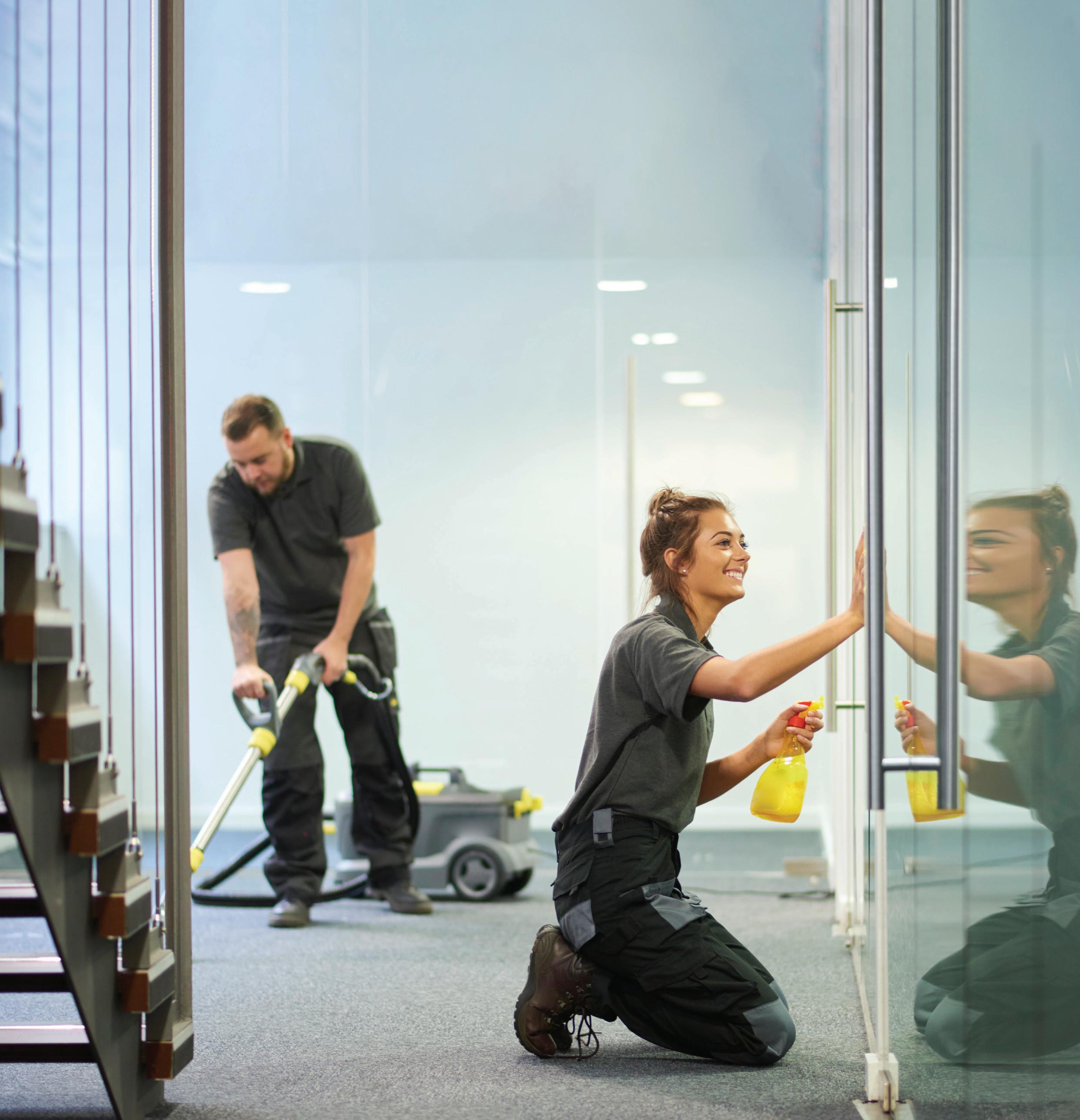PROCUREMENT’S EVOLUTION FOOD HYGIENE IN 5 STEPS THE SCIENCE OF CLEANING BOOSTING STAFF MORALE

THE STRONGEST LINK
Discover how due dilligence for a sound FSC® Chain of Custody is imperative for your business

PROCUREMENT’S EVOLUTION FOOD HYGIENE IN 5 STEPS THE SCIENCE OF CLEANING BOOSTING STAFF MORALE

THE STRONGEST LINK
Discover how due dilligence for a sound FSC® Chain of Custody is imperative for your business
The value of procurement teams has evolved in recent years. Procurement professional Leanne Whiter tells us how and why

With the new year in full swing, the first edition of Flair 2023 is here. We’re covering everything from Moffat’s new food-delivery system in the SDX Thermobox (pg 6) to the importance of hygiene audits in foodprocessing-facilities with Bunzl’s National Business Development Manager, Raymond Failla (pg 26).
We provide tips to ensure foodsafety in large commercial kitchens (pg 18) and deep-dive into the changing role procurement teams play in business profitability (pg 8). Join us as we discover the chemistry behind effective cleaning products (pg 24), before exploring the world of salami season in Australia (pg 22).
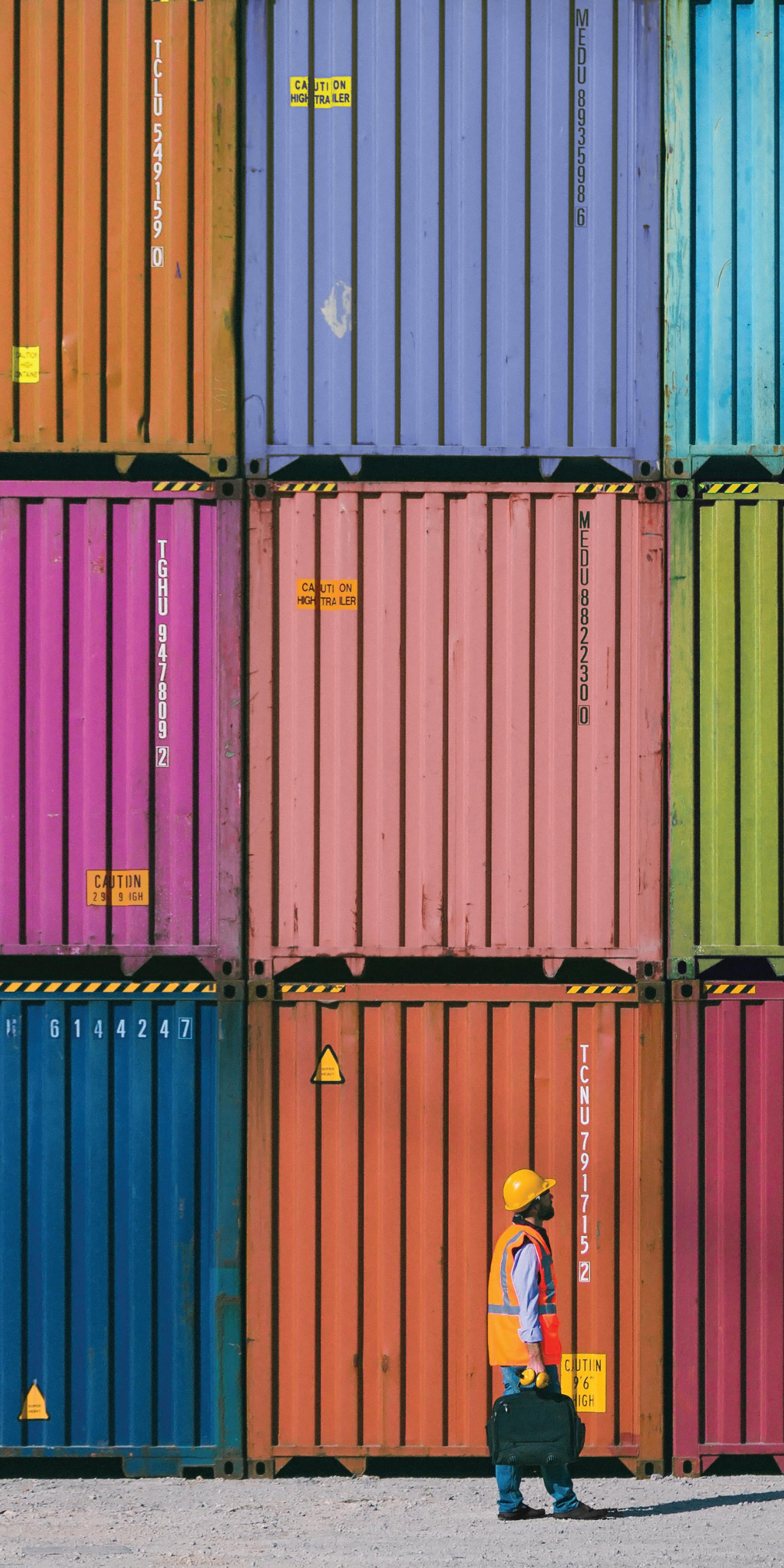
Bunzl’s recent sustainability endeavours have seen us honoured at the 2022 APCO (Australian Packaging Covenant Organisation) Awards in the Industry Education category (pg 4) while also ensuring an organisational focus on reducing freight impacts (pg 5). Learn more about the importance of the Forest Stewardship Council’s Chain of Custody in upholding ethical and sustainable sourcing (pg 12), and how Sustain’s White Paper Hot Cups allow an easy way for businesses to market at a local level (pg 7).
This edition, our feature guest is Procurement Consultant Leanne Whiter, who has enjoyed a stellar career in this essential area (pg 30), before chatting with Mark Paterson, Sector Manager for Healthcare at Bunzl Australia and New Zealand, on exciting industry innovations (pg 31).
I hope you enjoy this latest edition of Flair.
Lance Ward Managing Director, Bunzl Australia & New Zealand
@BunzlAustraliaandNewZealand
4 Spotlight: Sustainability
6 The Process: Food Tech on the Go
7 Check Out: Fill Your Cup
8 Rolling Evolution
Find out why procurement has shifted from a utility function to a crucial component of strategy development for businesses.
12 Chain Reaction
A company is only as strong as its FSC® Chain of Custody: discover why it’s as vital as ever to have a solid one in place.

16 Knives Out
Your need-to-know for handling this kitchen essential safely.
18 Prevention is Key
Five ways to keep food infection at bay in your place of business.
22 Worth the Wait
Learn a valuable life lesson about treasuring time and quality through the art of salami-making.
24 The Chemistry of Cleaning
Understanding the science of cleaning chemicals can save you time and money on the job.
26 Safety First
How a hygiene audit can boost staff morale and productivity.
30 A Cut Above
Procurement professional Leanne
Whiter talks to Bunzl about how the changing nature of procurement is adding value to business strategies.
Cover Photography: Graham Werner
31 Expert Q&A
With Bunzl’s Mark Paterson.
Cover Photography: Francesco Vicenzi
@BunzlANZHealthcare
Recognition for Bunzl’s education and initiatives in sustainable awareness.
WITH SUSTAINABILITY being a significant driving force behind many of Bunzl’s initiatives, the company has recently been recognised at the 2022 Australian Packaging Covenant Organisation (APCO) Awards, a prestigious industry event, for its education and implementation of sustainability initiatives.
Bunzl picked up the Packaging Future Award in Industry Education for engaging in several programs to support customer sustainability ambitions. APCO says the company’s efforts are “proactively supporting customers to improve their knowledge and use of sustainable practices and packaging to reduce overall waste”.
The work includes publishing numerous articles and fact sheets around the benefits of using sustainable packaging, providing range reviews to look for better
sustainable alternatives and the implementation of sustainable ambassadors nation-wide – all in a bid to proactively educate customers around green initiatives.
The APCO Awards are held annually and celebrate the achievements of leaders in business who are developing sustainable-packaging and recycling solutions.

“We’re honoured to receive this award in recognition of everyone at Bunzl who have continuously worked to engage our customers and others in our value chain to improve packaging sustainability,” says Bunzl’s Head of Sustainability Felicity King. “At Bunzl, we support our customers to make more informed decisions about the products they use and reducing the impact problematic plastic packaging has on the environment.”

Bunzl looks to minimise carbon emissions from freight.

IN A BID to further reduce carbon emissions, Bunzl is working on drastically cutting down the impacts of freight deliveries. With an aim already in place to reduce direct CO2 emissions from operations to zero by 2030 as part of the Asia Pacific Scope 1 & 2 Roadmap, we are now focusing on indirect emissions – Scope 3 – such as those produced in the course of deliveries.
To address the issue of emissions caused by freight deliveries, Bunzl is selecting carrier networks in Australia and New Zealand with robust vehiclereplacement policies and electric-vehicle transition plans, while encouraging the optimisation of freight and trip efficiency. We are also optimising Bunzl warehousing sites by designing more productive ways of fulfilling back-orders, increasing the efficiency of consignment despatch and maximising space with more streamlined order packing.
To that end, we have begun developing a supplier engagement plan and tool to measure emissions produced by freighting goods to customers, which will be put in place this year. Informed by the Global Logistics Emissions Council (GLEC) Framework, our sustainability team, working with carbon emission calculation experts, combine and analyse sales and freight data to determine delivery emissions and identify efficiency opportunities, such as order frequency at specific locations.
Most importantly, we are working with our partners and customers to achieve our net zero goals. Alongside companies worldwide, Bunzl is committed to the UN’s Business Ambition for 1.5°C and Race to Zero, with aims to be 25% more carbon efficient by 2025, 50% more efficient by 2030, and net zero by 2050.
As of 1 February, the Victorian Government banned problematic single-use plastics. Here’s Bunzl’s guide to single-use plastic alternatives.
PAPER STRAWS; REUSABLE/METAL STRAWS




BIRCHWOOD CUTLERY; REUSABLE STAINLESS STEEL OR REUSABLE PLASTIC CUTLERY




PAPER OR SUGARCANE PLATES; REUSABLE PLASTIC, METAL OR CROCKERY


WOODEN STIRRERS; STAINLESS STEEL TEASPOONS


SUGARCANE (BAGASSE) CLAMSHELLS AND CONTAINERS


PAPER CUPS; RECYCLABLE PET CUPS; REUSABLE CUPS


Boasting a cutting-edge temperature-control system and user-friendly design, the SDX Thermobox leads the way in food transportation.

WHEN IT COMES to food transportation, temperature is key: too high, food can lose its freshness or dry out, while too low, flavours can be compromised. Food-safety issues are also a risk if the correct temperatures cannot be maintained. And with the rush of peak holiday season – when the hospitality industry is at its busiest – safe and secure food handling is especially paramount.
Maintaining safe temperatures for food has required regular technological advances to provide solutions. Ice boxes have given way to gas-powered refrigeration, which has in turn given way to electric refrigeration.
Now, new technology from Moffat ensures that food is being transported at the optimal temperature at all times. The brand’s SDX Thermobox range –which includes insulated heated or chilled transport containers, or a combination of the two – employs a patented electronic system that keeps food

deliciously fresh and jam-packed with flavour. To maintain the optimal temperature in such a small internal space, SDX Thermobox is insulated with polyurethane, which expands under high pressure to fill the gap between the outer and inner walls.
At a time of heightened concern over exposure to pathogens, SDX Thermobox is also designed to be simple to clean. Built with stainless steel walls that are welded together rather than featuring joints or recesses, the units can be wiped clean easily.
And proving that every facet of the product has been carefully considered, SDX Thermobox boasts an ergonomic design based on consultation with final users. As such, the base and collision frame sit at a suitable height for loading and unloading, while a built-in tray track makes it easy to serve directly at the box. Rigorously tested, the SDX Thermobox range offers all you need for safe, clean, and effective food transportation.


A STRIKING LOGO design has long been key to strong brand recognition, whether it’s Coca Cola’s distinctive red cans and fluid white lettering or Nike’s imperious tick. It didn’t take long for cafes and restaurants to buy into the trend of easy branding, now using vivid colours and recognisable logos to turn takeaway coffee cups into their first line of marketing.
If your business has been considering stocking branded takeaway cups with a sustainable ethos behind production, the Sustain White Paper Hot Cup range could be the winning ticket. Made specifically to allow you to stamp your own design or logo onto the front, these takeaway cups provide the perfect blank canvas to promote your business in a unique way.
Branded cups are free advertising that allow exposure of your logo to a wider audience, highlighting your business’s identity and attracting new and repeat customers in the process. With sustainability a key consideration for businesses when it comes to packaging, these cups are made from renewable sources. They’re manufactured using materials made of Forest Stewardship Council® (FSC®-C117930) certified and other controlled sources (learn about FSC-certification on page 12), and lined with a BioPBS bioplastic lining derived from natural components such as sugarcane and corn, as opposed to traditional oil-based linings. This means the cups will break down into nutrient-rich organic matter when processed at industrial composting facilities. In short, better for the planet – and for your business.
BUSINESSES NEED TO BE AGILE IN THE CURRENT CLIMATE, WHICH IS WHY THE ROLE OF PROCUREMENT HAS EVOLVED TO BECOME MORE PROACTIVE AND STRATEGIC WITH MANAGING RISK AND GOVERNANCE.

In 2020, there was one word business leaders could not get enough of: procurement. What felt like an overnight shift, procurement moved from a utility function to a role delivering strategic guidance to help businesses survive the impacts of COVID-19.
Procurement teams worked around the clock to improve operational efficiencies and predict potential business and supply chain risks – all while maintaining existing supplier relationships.
However, the role of procurement has been evolving long before accelerated supply chain demands began shining a light on the profession.
Environmental, Social and Governance (ESG) principles in procurement processes have been growing in importance over the past five years, ensuring that business with suppliers is conducted in a manner that aligns with corporate and social responsibility (CSR) strategies.
The impact of procurement in delivering value – far beyond simple cost savings and margin optimisations – is an evolution Bunzl has witnessed first hand.
“The procurement area of the Bunzl business has always sourced the right product at the right quality and volume to deliver value and meet customer demands,” says Brendan Ahern, Director of Procurement at Bunzl ANZ.
“However, procurement today is much more than that. It now aligns with specialist areas of the business, as part of our drive to meet those demands and expectations, including working closely with internal sustainability teams and management of supply chain risks.”
Supply chain issues emanating from regional and global factors have continued to challenge procurement teams throughout the world. The war in Ukraine has had a destabilising effect on paper imports, with New European >
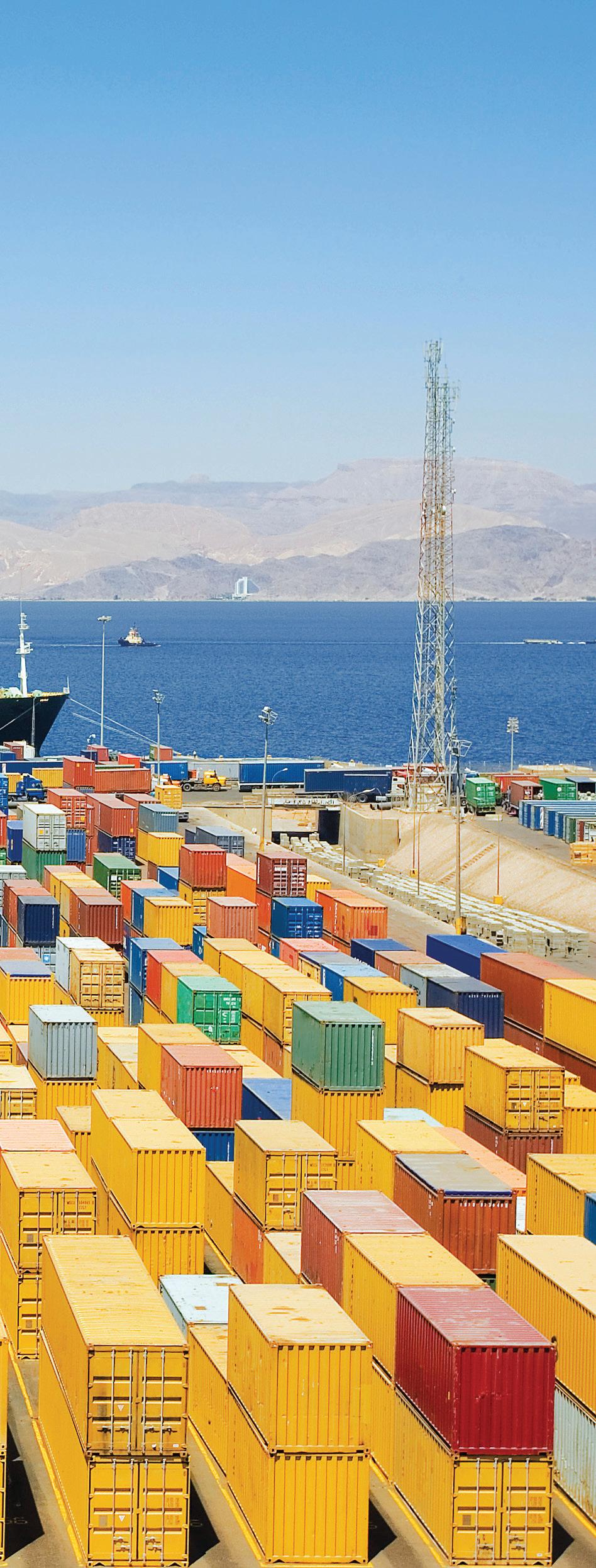
Union guidance declaring that Ukraine timber certified by schemes like Forest Stewardship Council (FSC®) no longer meets sustainable and legal forestry standards. Other global factors impacting supply chains include shipping delays and labour shortages which have affected every continent, including the Americas, Asia, Europe and, in particular, Australia. Since Australia is a country that conducts 98% of its trade through its ports (compared to the global average of 90%), local procurement teams have rapidly felt the effects of the global supply chain disruption and increase in shipping container costs.
According to Ahern, procurement teams now must look for multi-sources of supply to mitigate risk and ensure long-term growth.
“We have seen businesses with regional diversity in the supply chain control risk more effectively, as the pandemic peaked in different jurisdictions and at different times,” says Ahern.
Procurement teams who implemented a riskaware approach to manage potential supply chain vulnerabilities, were rewarded with improved supplier relationships and products delivered to cost and quality.

“The evolution of procurement within business moves it from its traditional utilitarian function to a highly strategic area, integral to the success of the bottom line of the business,” he says.

Today, sustainable practices have moved from being a nice-to-have policy to a must-have, with governments throughout the world looking to enforce ESG targets for business.
Procurement is at the forefront of this trend – ensuring the supply chain reflects all three elements of ESG principles and allowing businesses to include sustainable practices as part of the annual reporting process.
Environmental drivers have brought an increased focus on product and packaging, so they include recyclable and/or compostable materials and reflect a reduced use of plastics. Procurement leaders should look to continually optimise shipping to reduce fuel consumption and minimise carbon footprint. When sourcing paper products, FSC® certification is increasingly becoming non-negotiable.
Social policies have been focused on modern slavery. It’s reported that more than 40 million people worldwide are estimated to be living in slavery, with nearly 25 million of those in forced labour. Businesses are responsible for ensuring sourcing is ethical and lawful. One way to ensure the labour force is protected is to run audits throughout the supply chain.
As governance continues to come under the spotlight, businesses must be mindful of
the continuous disclosure rules imposed by regulators. This includes improving production using solid data and reporting to business stakeholders and customers. Procurement teams also work to help customers reach their own ESG targets. At Bunzl, we have plastic and sustainability experts who proactively support our customers with their sustainability challenges and sourcing.

Following the rules of continuous disclosure and meeting strong ESG targets depends on reliable, accurate and timely information being available. Procurement teams have become adept at using data strategically to allow analysis and agile responses to supply issues. This empowers procurement teams to confidently make more informed, data-led decisions.
Bunzl uses data-led insights both internally and externally, providing best-practice solutions for the company – and their customers.
“Data has always been important to business, but these days we are meeting not just our internal requirements but also assisting our customers to meet their sustainability targets. Data is vital to the sustainability of businesses, the planet and social responsibility,” says Ahern.
Labelling food consistently and correctly ensures that you are serving the freshest and safest food, as well as reducing costly waste.
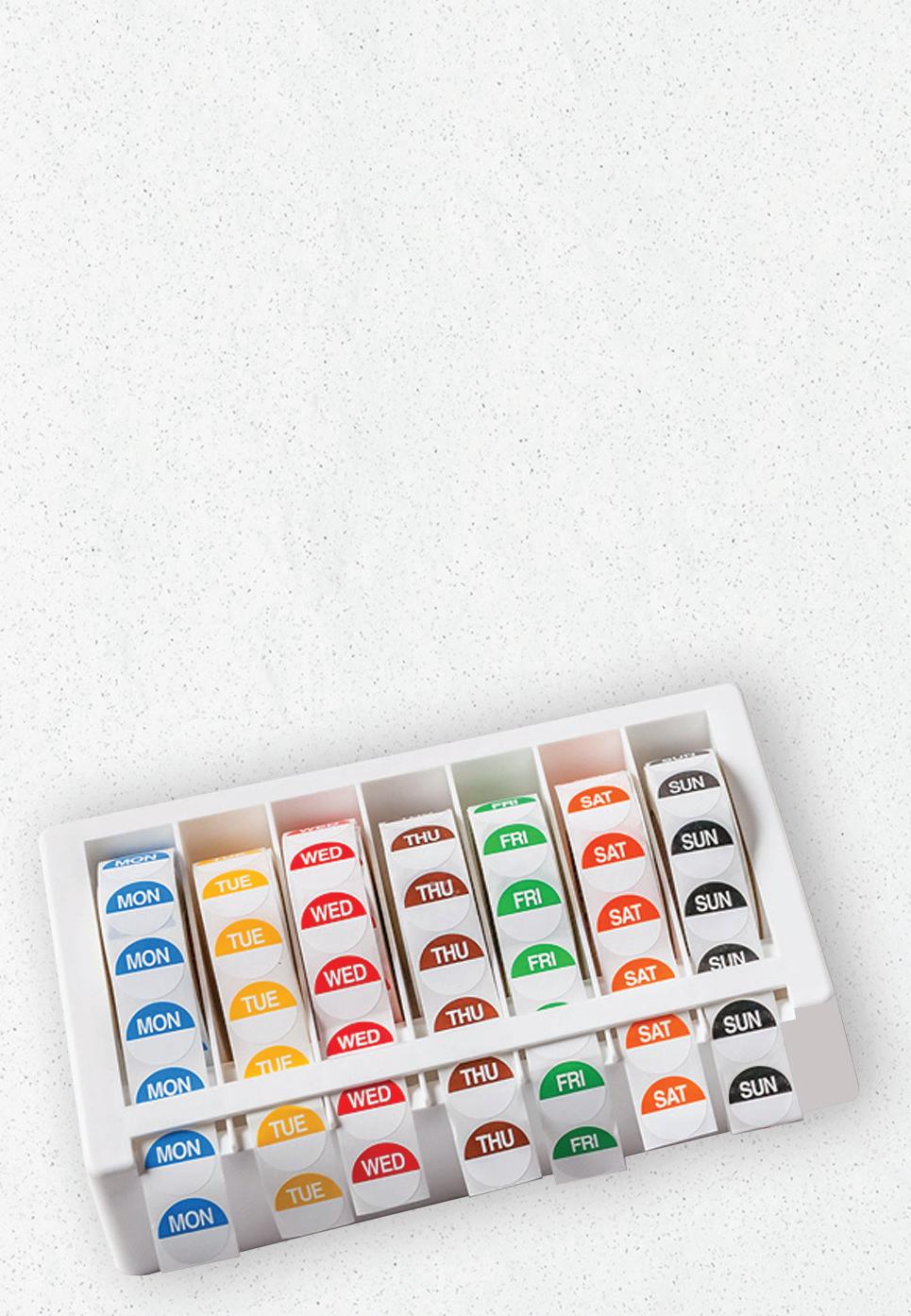
Made from rPET (Recycled Polyethylene)

IT’S AS IMPORTANT AS EVER TO CONDUCT YOUR BUSINESS THROUGH A SOUND FSC® CHAIN OF CUSTODY TO EFFECTIVELY VALIDATE CLAIMS MADE ABOUT YOUR PRODUCTS, PROCESSES AND SERVICES.
It’s estimated that the value of illegal timber imported into Australia each year stands at around $400 million. This can be the result of logging done in contravention of forestry protection or labour laws around the world, meaning that the timber has come from protected forests or production where child or slave labour has been involved.
Certain regions are in a constant battle to identify the origination and stem the sale of illegal timber. In Africa and South America, for example, between 50% and 90% of timber is harvested and traded illegally. The chain reaction
of this is equally severe, with a huge range of products made from illegal sources. This is where the Forest Stewardship Council® (FSC®-C117930) Chain of Custody – which guarantees products have been produced in a way designed to protect the health and resilience of forests worldwide –plays an important role.
At a time when sustainability and corporate social responsibility is becoming a key priority across every industry, it’s vital that businesses are not only aware of the FSC® Chain of Custody, but can ensure they are purchasing from compliant companies.

As a rule, a chain of custody is a process used in supply-chain management to record and disclose the origins of materials, as well as provide a regulated chain of custody that identifies each step of production before their sale. In short, it’s a system of traceability and accountability. This is especially important as a way of enabling businesses to avoid purchasing products that may have been produced illegally, whether at source or somewhere else along the chain. When it comes to forest-sourced products –which can mean anything from paper towels
and disposable plates to rubber gloves and wooden furniture – the FSC® Chain of Custody is essential. Particularly in hospitality, healthcare, food processing or large event facilities where purchasing timber-derived products is common practice.
When purchasing materials or products that are derived from a forest source, it’s important to look for FSC® certification, which is used on labels worldwide and is recognised globally. If a product has FSC® chain of custody certification, >

These heavy-duty disposable wipes ensure a streak and lint free fnish on any surface with hexagonal embossed paper that grips dirt and grime. Available in rolls and single dispenser sheets, 3D Hex products are HACCP International certifed as a food safe product.
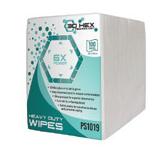


HACCP International Certifed
3D Hex wipes and wipers are HACCP International certifed meaning they are suitable for use in facilities that operate in accordance with a HACCP International based Food Safety Programme. This is an internationally recognised method of identifying and managing food safety risk.
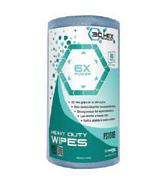
it comes from either FSC®-certified forests or wood that meets the requirements of the FSC® Controlled Wood standards. These standards state that wood cannot be harvested illegally, in violation of human rights, in forests which threaten conservation efforts and in forests being converted for non-forest use. Many businesses do not partner with, or purchase stock from, companies without FSC® certification. For any company, there are a number of steps that should be taken to follow best practice around chain of custody. These include:
1Administer an annual independent audit. If you buy or sell timber-derived products, an annual audit will provide a comprehensive overview of whether manufacturing is FSC® compliant or not.

2 Maintain accurate records.
It’s vital to retain an accurate paper trail of all transactions around forest-sourced products for corporate governance and compliance.
3 Conduct regular training. Every member of staff in your business needs
to be well versed on chain of custody to ensure that all incoming products – and any packaging – are FSC® compliant.
It’s thought that around 18 AFL fields worth of forest are cleared every minute across the world. With stats like this, it’s clear that the conservation and renewal of forests is vital for the future health of our planet.
Bunzl has long recognised that sourcing FSC®certified products helps address this issue, and continues to put sustainability at the forefront of everything we do. Bunzl’s own exclusive brands include Pristine washroom paper, Sustain wooden and paper utensils, and Katermaster baking paper and napkins which are FSC®certified and each fully compliant with the FSC® chain of custody. This includes the materials used to package and transport these products. By leading by example, we can create a sustainable environment and raise awareness of ethical sourcing and the promotion of responsible forest management.
When it comes to forest-sourced products – which can mean anything from paper towels and disposable plates to rubber gloves and wooden furniture – the FSC® Chain of Custody is essential.
HELP
Expert knife work is often the culprit behind a delectable dish or a perfectly butchered cut of meat. But if not handled correctly, knives are also the culprit of many workplace injuries. While power and sawing tools come with safety guards and kill switches, hand-held knives don’t offer the same luxury. Which means the safety of your employees comes down to knife-safety education and handling.
4 knifehandling tips 4
Always cut away from yourself. Always cut on a stable surface. Never try to catch a falling knife. Wear cutresistant gloves where possible.
Scan here to see Khabin’s knife range.
DID YOU KNOW?
The highest percentage of injuries in meat-processing industries come from cuts to hands and fingers – from cutting equipment, including knives.
Source: Workplace Health & Safety Queensland and WorkSafe Victoria
NOT ALL BLADES ARE CREATED EQUAL. KNOWING WHAT INGREDIENTS BLADES ARE DESIGNED FOR CAN PREVENT INJURIES.
Keep knives sharp
Blunt knives require more pressure which can result in slips.
Clean safely Sharpen knives safely
Hold the blade’s edge at a 20degree angle to the steel sharpener.
Lay the blade flat on a surface when cleaning with a wet cloth.
DID YOU KNOW? With over 500,000 workplace injuries occurring annually in Australia, 6% happen in the food-service industry.
Safework Australia
Store safely
Store your topquality knives in a knife roll to keep in perfect condition.
PREVENTING FOODBORNE ILLNESSES IS VITAL IN LARGE FACILITIES AND HEALTHCARE SETTINGS HERE’S FIVE WAYS TO AVOID FOOD INFECTION.

Maintaining food hygiene in healthcare and aged-care facilities is crucial for the wellbeing of residents and staff. Food poisoning can have a ruinous – sometimes deadly – effect on those with already weakened immune systems. That’s why every facility of this type needs strict governance in place around food safety to ensure outbreaks are avoided. The same is true of large catering facilities such as events centres, where outbreaks of foodborne illnesses can occur if steps aren’t strictly followed to prevent the spread of germs during the production process.
So how can facilities of this scale ensure outbreaks don’t occur? Here are five steps your business can take to guarantee hygiene in a large, multifaceted workplace.
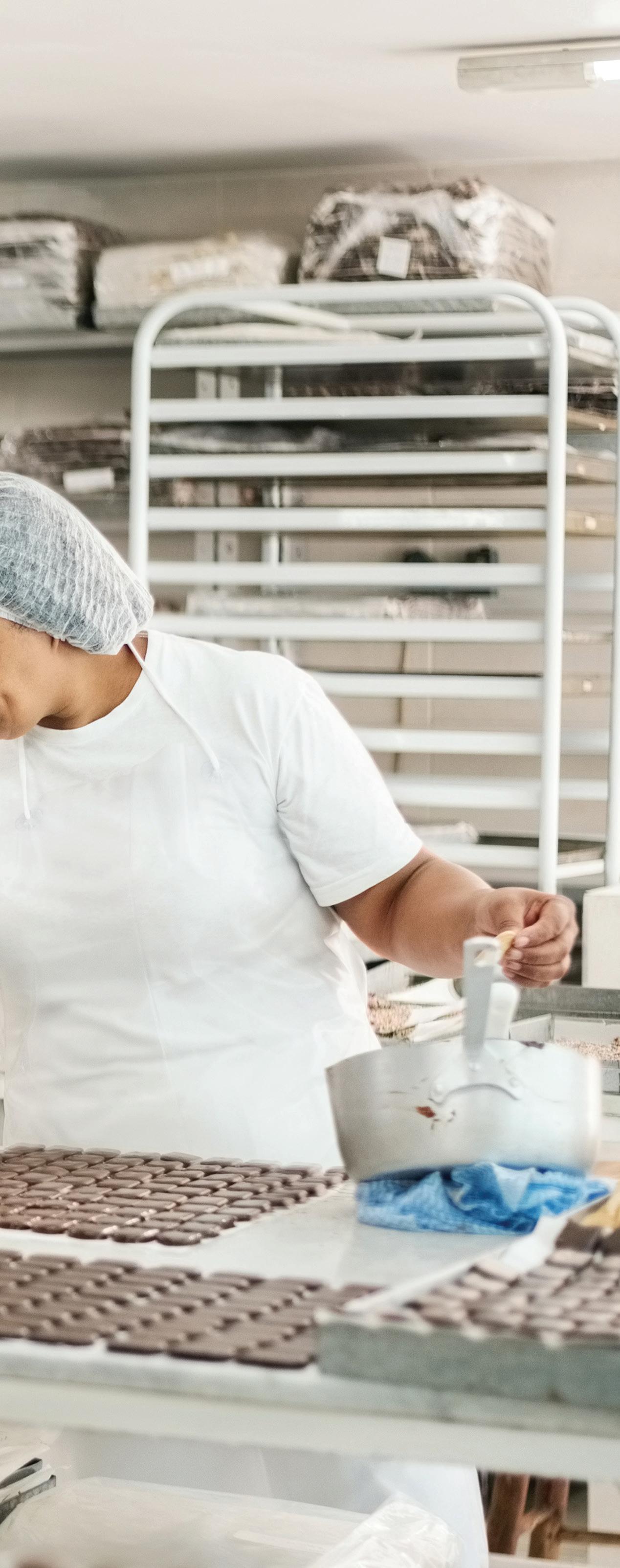
1ADOPT AN EFFICIENT COLOUR CODED CLEANING SYSTEM
Preparing food in large quantities can lead to a build-up of grease and dirt that can quickly become unmanageable if not maintained, so cleaning needs to be organised and efficient. Adopting a clear and consistent colour-coded system for cleaning supplies can help reduce risk of cross-contamination within large commercial businesses. According to the NSW Government’s Cleaning of the Healthcare Environment Policy Directive, colour coding is considered the most effective system for restricting cleaning equipment to individual areas. The policy suggests:
GREEN: Kitchens, food preparation areas, food service areas
BLUE: General cleaning, offices, low-risk areas
RED: Toilets, bathrooms
YELLOW: Infectious areas, isolation areas
WHITE: Clinical areas, operating theatres. >
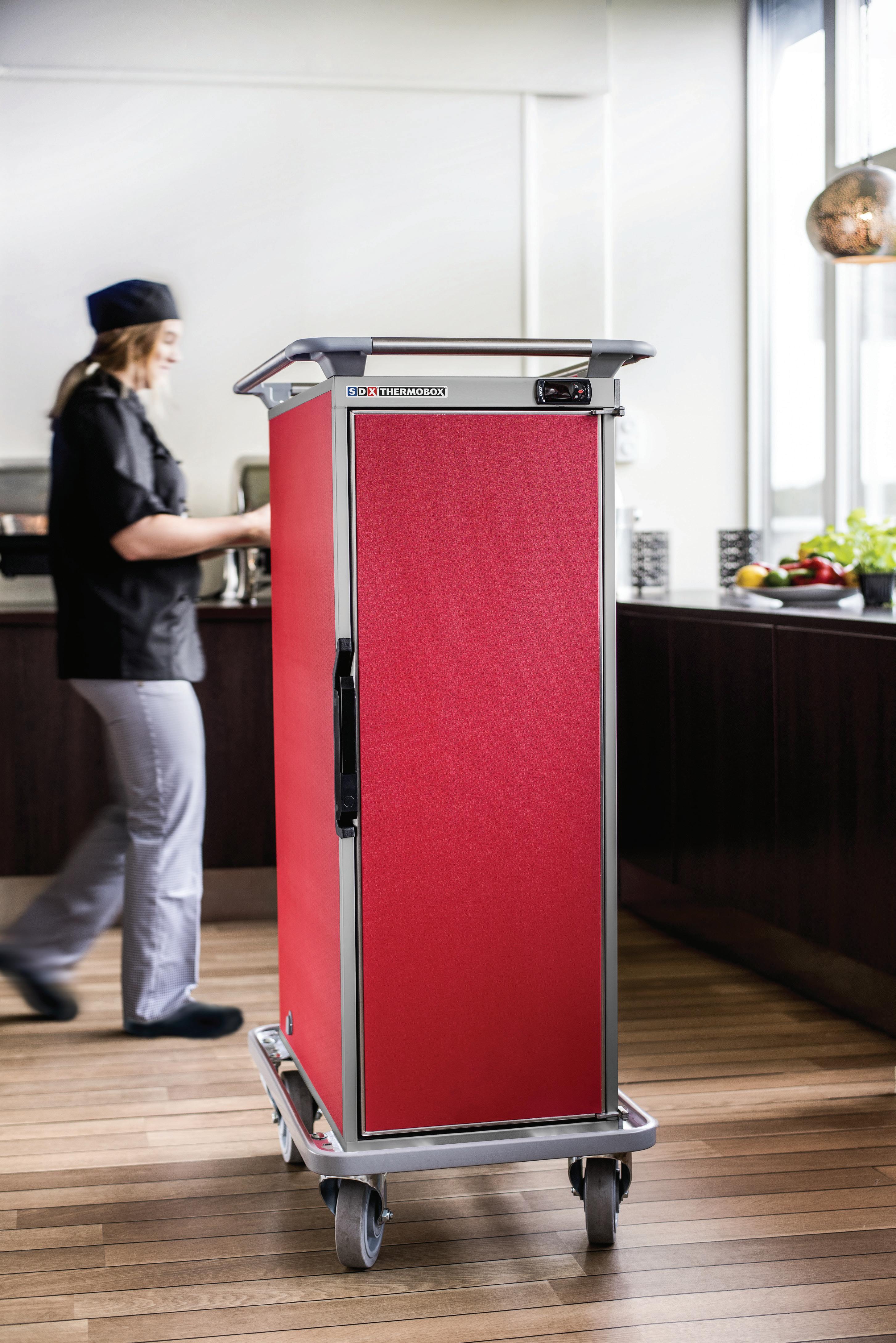

Research has found that cloths used multiple times to clean dishes and wipe surfaces can harbour a wealth of bacteria, including E.coli. The same goes for tea towels. Reduce this risk by employing disposable cloths and paper towels that can be thrown out after use – especially important in a healthcare or aged-care environment, where contamination is particularly dangerous. From a hygiene perspective, paper towels are superior to electric air dryers. According to the Mayo Clinic, a nonprofit academic medical center, drying hands thoroughly with single-use, disposable paper towels is the preferred method of hand drying, and the most important measure to reduce the burden of healthcare-associated infection.
Storing food correctly in fridges and freezers will not only reduce waste and help your bottom line, it will also reduce the risk of food becoming unsafe to eat. If you run a large events company, it’s a good idea to design a strategy for staff on where certain foods, such as fish and meats, should be kept in the fridge as a way of ensuring the food that needs to be used up first is easiest to access. In a big operation, food can get easily muddled, so train staff to clearly label any food they open and put back in the fridge or freezer as they open it. It’s a small job that will save large problems in the long run.

Workplace training and education is vital for maintaining high standards of hygiene in commercial kitchens and healthcare settings.

This should include a focus on personal hygiene and sanitation, as well as refresher lessons on the likes of hand washing and the basics of how germs are spread. Never assume this is too simple. Staff turnover is often high in large-scale facilities, so it’s important to schedule regular catch-ups to go over the fundamentals.
You may decide that plastic or vinyl gloves are essential in some food-preparation settings – kitchens providing food for healthcare and aged-care environments should be especially wary of bacteria from a person’s hands infecting food. Train staff to use gloves when handling raw meats and fish in particular, and to wash their hands after the gloves have been disposed of. Equally, hair can contain harmful pathogens, so to prevent stray hairs landing in food, encourage the use of hair coverings.
Every year, when days and nights start to turn cold, the beginning of what is known as salami season commences. One of the world’s longest held curing traditions – salami originated among a group of Roman salted meats called salsum, deriving from the Latin word for salt, sale – salami season is steeped in centuries-old preparation and curing techniques, and a little patience.
For many retail butchers in the Southern Hemisphere, summer signals that the salami cured throughout winter is ready to be served to eager customers. While mass-produced salami slices can be found in most supermarkets, there is something about this time-
honoured tradition using the finest ingredients to produce quality salami that appeals to butchers and foodies alike. Because quality is not just about the finished product, but also about how it is produced.
Here are a few lessons salami season can teach us about upholding quality.

While our society, with its speed in production and information, is feeding our impatience and the need for instant gratification, salami season is teaching us the opposite.
As has been known for generations, salamimaking is all about the process. It's a hands-on, timeconsuming journey full of tradition, flavour and skill, and more importantly, patience. It requires constant attention to control the process inside the sausage. Monitoring humidity levels for quality control and establishing the right storage environment over time all play a role in the development of a delicious sausage.
A flavoursome and quality salami is like a chain, it's only as strong as its weakest link. You may have the best cuts of meat and the right mix of spices and flavourings and still not produce a high-quality salami if the rest of your supplies aren't up to scratch.

Take netting, for example. As the final step before hanging the meat, it is responsible for holding the meat together. But if that netting loosens over time during the curing process, the quality, shape and even
the flavour of your salami may be less than desired. Having quality control processes in place, even for the smallest of elements, can go a long way in ensuring quality goals don’t suffer as a result of sub-par supplies.
Clichéd corporate terms aside, keeping longheld traditions alive takes more than record keeping and a group of passionate people; it takes an army. There’s no shortage of this when it comes to salami season.
A collection of butchers, home-cooks and Italian food-lovers, known as the ‘Salami Army’, come together once a year to celebrate the salami season through festivals across Australia. While the festivals have been put on hold since COVID, preserving the aged-old salami-making recipes and methods are still being passed on through generations of Italian families, butchers and salami-makers: an integral part of ensuring high-quality and flavoursome salami endures for decades to come.

To make the best salami of the season, only the fnest ingredients will do. Bunzl’s wide range of cures, salts and natural casings will help take your salami from good to exceptional. Bunzl – helping salami-making traditions stay alive across Australia and New Zealand.
LEARNING THE DIFFERENCE BETWEEN CLEANING CHEMICALS COULD HELP YOU SAVE TIME AND MONEY ON THE JOB.

Cleaning can seem like a routine task, but when tackling commercial facilities, large spaces or high-traffic areas it’s often arduous and time-consuming.
This is where an understanding of why certain chemicals cut through grime and bacteria and others don't, is key to an efficient clean. Knowledge of cleaning chemistry will save your business both time and money by utilising a targeted approach to cleaning. This is true of all areas where you’re likely to encounter an accumulation of dirt and bacteria, whether in kitchens, food-production facilities, public restrooms, or places with acres of floorspace, such as airports, hospitals and events centres.
One specific area of chemistry can be especially useful to learn: the pH scale. This is
Scan here for the full range of Kwikmaster Professional cleaning products.

the measurement of acidity or alkalinity when a chemical is mixed with water – where zero represents the most acidic and 14 means high alkalinity. In a nutshell, anything recording a pH of 7 is considered neutral, while a pH of below 7 is acidic and above 7 is alkaline.
Why does this matter to cleaning? On the whole, most cleaning chemicals have high alkalinity as it’s more effective for corrosion and breaking up grime (think bleach, baking soda and ammonia) or have a base that reacts with acids to make substances dissolvable in water.
If a stain or other soil build-up has an acidic quality or is organic in nature like fats, grease and oil, a cleaning chemical with alkalinity will break it down and convert it into an easily washable solution. Simple, right? So, when should you be using an acid or alkaline-based cleaning chemical?

Take a busy kitchen, which, through the course of a day, will produce a large amount of oily residue and other dirt build-up on its surfaces and floors. These stains and soils are best cleaned with a high alkalinity chemical as it breaks down and converts the build-up into a solution that is easily wiped away.
For a small kitchen, a mild alkaline product with a pH of around 8-9 is likely to be enough to do the same, while for higher-traffic areas such as those in food processing and production, a heavyduty detergent like Kwikmaster Professional K5 Oven & Grill Cleaner, with a pH of 11 or more, is more effective.
On the other hand, toilets and washrooms, for instance, are generally dirtied with alkaline mineralbased bacteria and materials. An acidic or citricbased cleaning product, such as Kwikmaster
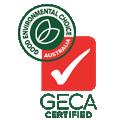

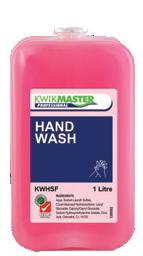


Professional H17 Toilet And Urinal Cleaner, will work best for scrubbing these areas due to its natural anti-bacterial, anti-fungal and degreasing properties. In a concentrated form, it can also dissolve hairs and toilet paper. For areas such as showers and swimming pools, acid-based cleaners should be used because they lower the pH and total alkalinity of the water.
By understanding how different cleaning products work, your business is better equipped to maintain an efficient clean every time.
Kwikmaster Compostable Bin Liners are a sustainable alternative to traditional virgin/recycled plastic or oxo-degradable bin liners. Made from plant-based material, they are 100% GMO free and can be disposed of in home or commercial composting or in landfll. If composted, these bin liners will breakdown and become fertiliser – while leaving no microplastics behind.
Kwikmaster Compostable Bin Liners are made from a blend of random copolymerpolybutylene adipate terephthalate (PBAT), polylactic acid (PLA) and corn starch. They are available in a variety of sizes to suit any businesses needs and are made in accordance with Australian/NZ home and commercial compostable standards AS5810 and AS4736.

FAILING TO MEET FOOD SAFETY STANDARDS CAN LEAD TO LOW MORALE AND POOR PRODUCTIVITY AMONG STAFF. BUNZL EXPERT RAYMOND FAILLA EXPLAINS WHY A HYGIENE AUDIT COULD GIVE YOUR BUSINESS THE BOOST IT NEEDS.

As with any business, running an efficient commercial food-processing facility relies on gradual improvements in productivity and efficiency over time. To achieve both, staff morale needs to remain high – an aim that’s easier said than done when taking into account everything from salary expectations to job satisfaction. But one variable that can be controlled is factory hygiene. Allow standards to drop and OH&S can be compromised, causing staff morale to suffer.
Many businesses overlook what is required to meet the Australia New Zealand Food Standards Code, and as a result are failing to protect their staff; physically and emotionally. An annual food-safety audit will help your business realise the steps that need to be taken to be fully compliant with regulations and, importantly, establish trust with your employees that their hygiene is protected through company action and the use of the right products and processes.
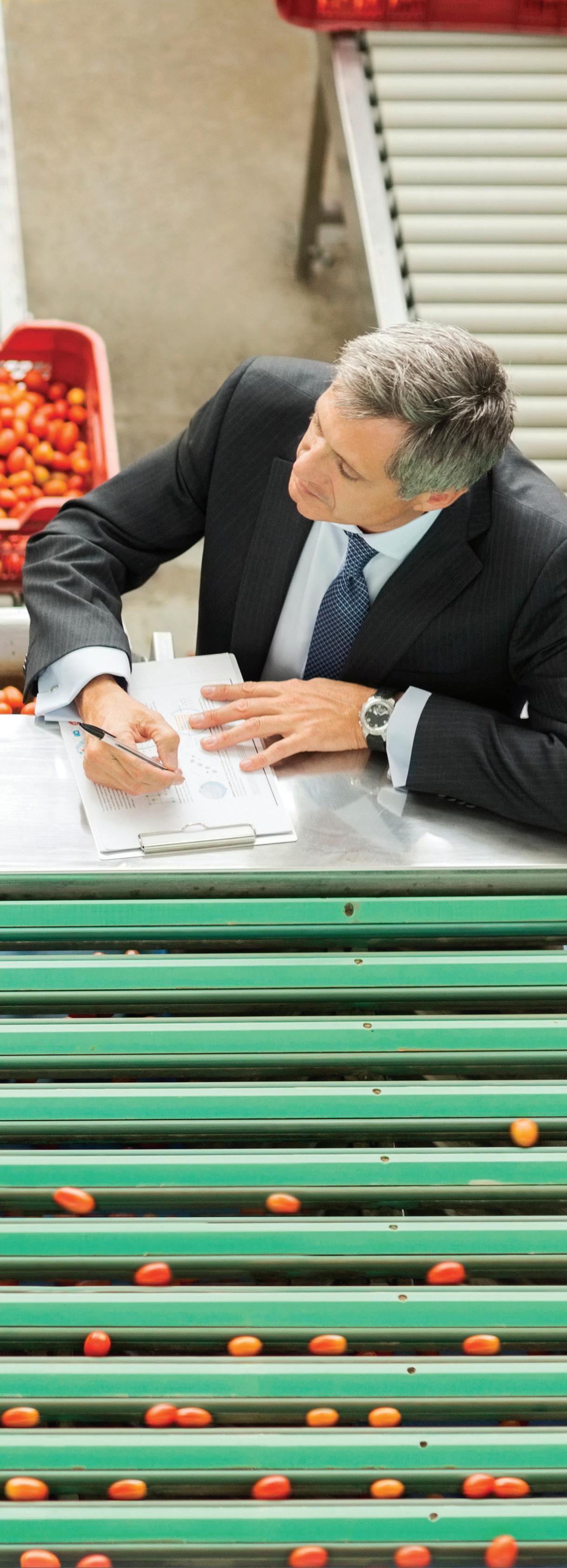
“Elevating hygiene standards onsite has a positive impact on employee engagement and that demonstrates an organisation’s care for their employees,” says Raymond Failla, Business Development Manager Processor & Industry at Bunzl. “Site audits are fundamental to driving improved processes and outcomes.”
His advice to companies is to enlist outside help from a hygiene specialist who can conduct the audit. “[You should] engage with industry professionals who have the knowledge and experience to support on key areas such as health and hand hygiene requirements, cleaning, sanitising and surface wiping,” he says.
With a complete site review, an expert can “share knowledge, insights and best practice”, explains Failla, while gaining an understanding of “the current state [of the business], challenges, and opportunities for improvement aligned to the organisation’s key business >
drivers, such as sustainability goals”. Following on from this, they can, “put forward a list of recommendations to review and implement”.
On a practical level, this means you will have access to a key site contact who can conduct a walk-through of your factory and review everything from the cleaning products used in the factory to whether soaps and sanitisers are accessible, carry the required certifications, are placed in the correct locations and are clearly marked or labelled. They will then make suggestions on any changes and adjustments that need to be implemented. This will aid your organisation to hone in on what will improve efficiencies and productivity.
When an expert does a walkthrough of your facility, key areas of focus will include (though will not be limited to):
• ensuring hand hygiene and surface wiping solutions carry correct Hazard Analysis and Critical Control Point (HACCP International) certification or Food Zone Primary (FZP) classification;
• making sure companies use food-grade handsoap and sanitiser in a cartridge system over a bulk-fill system;
• highlighting the consolidating of vendors and consumables, which can lead to ordering efficiencies, reduce wastage/storage, and cost reduction;
• whether soaps and sanitisers are accessible, carry required certifications, are placed in the correct locations and are clearly marked or labelled.
A site audit is also designed to help customers improve their onsite sustainability objectives by moving towards renewable or reusable materials where possible.
According to Failla, getting on the front foot is key. “Be proactive, not reactive. Work with suppliers who share similar goals, particularly around sustainability and ethical sourcing.” he says.
Ultimately, the result is likely to be a business which is more hygienic and sustainable, promoting higher production among staff who feel safe and looked after.
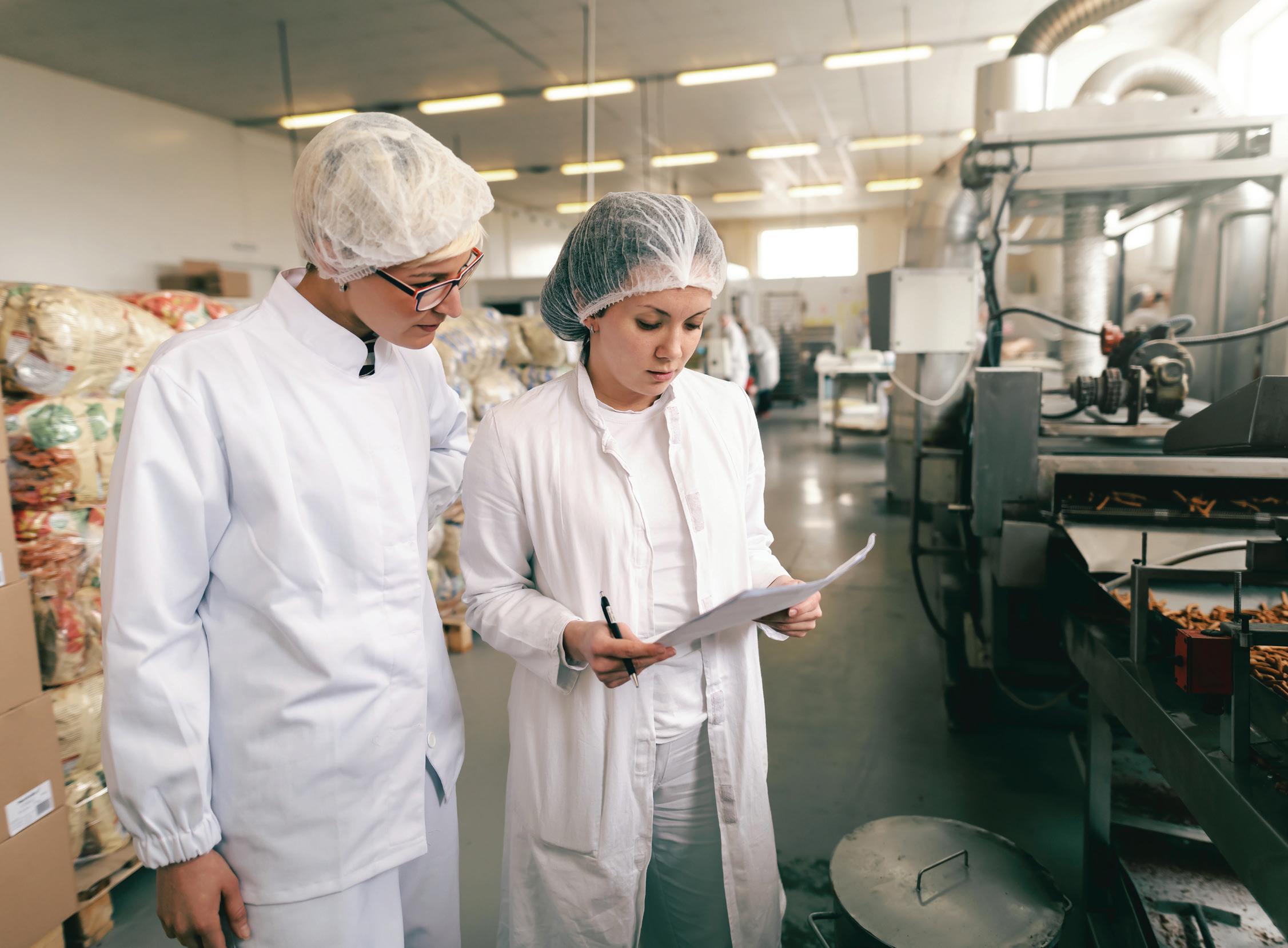
“Elevating hygiene standards onsite has a positive impact on employee engagement and that demonstrates an organisation’s care for their employees.”
The P REMIUM P LUS range offers a high-quality and cost-effective solution for your washroom.

Cleanliness and hygiene in a facility washroom is crucial to ensuring customer and user comfort. From slim dispensing systems to premium quality hand-towels, Pristine’s PREMIUM P LUS hand towels improve hand hygiene in washroom settings with Through-Air-Dried (TAD) technology and a unique dimpled pattern to maximise softness and absorbency.
TAD Technology is the process used in tissue manufacturing that creates higher absorbency whilst achieving towel softness. The spreading of tissue fibres creates absorbency pockets that

draws water in and drys hands faster – reducing both consumption and wastage.
A study published in the Mayo Clinic Proceedings (2012) discovered the following when it came to different hand-drying methods in professional washroom settings:
• The availability of paper towels can improve hand hygiene among washroom users.
• Disposable paper towels are the preferred method of hand drying for the majority of participants.
• Less paper usage due to higher absorbency can reduce waste.
The Pristine P REMIUM P LUS hand
To find out more visit www.bunzl.com.au/pristine
towel range is made from Forest Stewardship Council® (FSC®-C117930) certified materials. The range is also HACCP International Certified meaning it is suitable to use in facilities that operate in accordance with a HACCP international-based food safety programme.
The procurement professional and sought-after consultant discusses the evolving nature of procurement and why, for the first time, business decisionmakers are paying attention to the value procurement teams can add.
The role of procurement has steadily evolved since Leanne Whiter began working for Britax Brylite over 30 plus years ago, and in the past few years it’s gone into overdrive.

Whiter has seen the parameters of procurement change from basic purchasing and buying to sitting across the whole of a business driving strategic value across different categories.
These days, that means liaising with national, and often multinational, suppliers, strategic sourcing and the management of supply chains. The complexity quickly became apparent during the pandemic where managing unpredictability required a new level of communication and agility. Flexibility and resilience is what Whiter believes you need plenty of to successfully work in procurement.
Recently starting as a consultant with Chemovar, a medical cannabis company, in a Procurement/ Supply Chain role, Whiter is responsible for driving value for Chemovar and supporting the end users. “Procurement is a job where no two days are the same,” she says. “We are lucky we get to work with a lot of different departments and businesses, which makes procurement really interesting. We’re the mortar between the bricks.”
For Whiter, who has worked across a host of different industries including automotive, manufacturing and most recently within healthcare, she is now seeing procurement evolve to become more data-driven. “While procurement teams have always used data to inform supplier and risk-management decisions, the emergence of new data sources, real-time insights and AI intelligence has transformed the function into problem solvers.”
According to Whiter, it is usually the mature organisations who are willing (and able) to invest
“It’s all about relationships, and when times get tough and challenging, as they did in the past couple of years, you’re able to tap into those relationships and know who you can trust.”PHOTOGRAPHY: FRANCESCO VICENZI
in the right software and people, as they know the strategic value a leading procurement team can bring to a changing operating landscape.
That changing landscape now very much includes two topics – one of which has been a mainstay in the news throughout the past 12 months: modern slavery and cybersecurity. In ensuring the viability and security of supply chains from all angles, procurement leads such as Whiter are having to consider a new generation of challenges, including guarding against hackers.
“Cybersecurity and data security have become really big things for procurement teams,” explains Whiter. “In fact, given the recent headlines [around cybercrime], it’s probably what’s impacting procurement teams the most at the moment.
“When we’re talking with suppliers or any new business, it’s the cybersecurity that seems to be at the front of everyone’s mind. We must work with our IT Department to ensure we have the right systems in place to ensure the safety of our data.”
Whiter says emphasis must be placed on risk management, as businesses ensure modernslavery and sustainability values and guidelines are met. And with global supply chains stretched, there is also pressure on her to guarantee suppliers are able to fulfil obligations.
She says surety of supply became paramount during the pandemic while working as Category Manager at one of the largest providers of aged care in Australia. “It was really hard,” she admits. “We were all learning together and putting together governance and new processes. It took a lot of collaboration and planning. Everyone was stepping out of their comfort zone. It was really hard to get stock to ensure the safety of our staff and residents; however, there were some really good suppliers that we could rely on.”
Ultimately, Whiter claims that one of the key reasons she was able to continue sourcing products during the pandemic was because she had already established solid partnerships with suppliers. The people she works with is what lies at the heart of her job above all things – and what keeps her absorbed in a procurement career that began so many years ago.
“It’s all about relationships, and when times get tough and challenging, as they have in the past couple of years, you’re able to tap into those relationships and know who you can trust and rely on,” she says. “I think everyone brings different strengths to the team. And I really think that if you’re working with a good team or different stakeholders in the department, this is what makes all the difference. This and really good and open communication and sharing knowledge.”
MARK PATERSON Sector Manager –Healthcare
Sector Manager –Healthcare
Tell us about your career path at Bunzl. I started at Bunzl in 1997 as the Key Account Manager for Queensland where I worked mainly with food processing and food retail customers. After moving into the Healthcare sector, I progressed into a business development role mainly looking after the hand hygiene category before managing a portfolio of large national healthcare accounts. Early in 2021 I began developing a team to manage our National Corporate Healthcare accounts and from there moved into the role of Sector Manager for Healthcare in early 2022. When it comes to your role, what do you appreciate the most? That by being part of the Bunzl team I can provide our healthcare customers with services and products that will then allow them to provide quality care for their residents and patients. What are some of the most important considerations when it comes to new products for you? When looking at a new product, the first thing I will always consider is whether the product fills an existing need in the market. Secondly, I look at the possible benefits that product will bring to healthcare providers. Lastly, and one of the biggest considerations, is whether the product will fit within the overall Bunzl Healthcare strategy. What are some of your career highlights? One of the things that I take pride in is my team’s part in ensuring that Bunzl is seen as a professional and reliable supply partner by major healthcare providers across Australia and New Zealand. Take the recent pandemic and all the difficulties that came with it – as Bunzl employees, we should be proud of the way we navigated those difficult circumstances, and how we represented the business and conducted ourselves during such a challenging period. Are there any innovations in your industry that you’re particularly excited about?
One of the areas I find most exciting – and at the same time challenging – is the focus on sustainability in the healthcare sector. It’s exciting that a number of our customers are not only solely focused on just purchasing more sustainable products, but also have specific objectives to ensure they have measurable sustainable processes in place.
Mark tells us about his role as Sector Manager for Healthcare where he provides customers with sustainable solutions to help them look after their residents and parents.
QUICK FIRE Q&A
